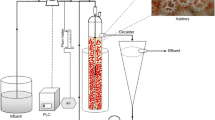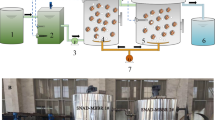Abstract
Anaerobic ammonium oxidation (anammox)-based nitrogen removal saves aeration energy and organic carbon costs, attributed to its anaerobic and autotrophic nature. However, due to the slow growth of anaerobic ammonium oxidation bacteria (AnAOB), drawbacks including long startup time and sensitivity to toxins still hamper the application of anammox-based processes. To cope with the slow growth of AnAOB, various bioreactor configurations have been investigated for the capability of retaining anammox biomass, among which, the expanded granular sludge bed (EGSB) reactor is a promising option. In this study, two laboratory-scale EGSB reactors were used to gain insights of microbial population and their response to amending biofilm-carriers, aiming to enhance the biomass retention of AnAOB. The respective ammonium and nitrite removal efficiencies were up to over 90%, and the overall nitrogen removal efficiency (NRE) was stable at over 70%, in the EGSB reactor amended with carriers (CEGSB). Compared to the control EGSB, CEGSB’s observed performance was more stable during the 236-day operational period. The abundance of AnAOB reached 22% in the EGSB and 49% in the CEGSB. It was also observed that Ca. Brocadia (14.25%) and Asahi BRW2 (33.19%) coexisted in the CEGSB. The dynamics of major metabolisms and functional genes involved in nitrogen conversion were further observed by FAPROTAX based on the taxonomic data, providing more insights into the functions of the microbial communities.






Similar content being viewed by others
References
Abma WR, Driessen W, Haarhuis R, van Loosdrecht MC (2010) Upgrading of sewage treatment plant by sustainable and cost-effective separate treatment of industrial wastewater. Water Sci Technol 61:1715–1722. https://doi.org/10.2166/wst.2010.977
Ali M, Okabe S (2015) Anammox-based technologies for nitrogen removal: advances in process start-up and remaining issues. Chemosphere 141:144–153. https://doi.org/10.1016/j.chemosphere.2015.06.094
APHA (2005) Standard methods for the examination of water and wastewater, 21th edn. American Public Health Association Inc, Washington DC
Awata T, Oshiki M, Kindaichi T, Ozaki N, Ohashi A, Okabe S (2013) Physiological characterization of an anaerobic ammonium-oxidizing bacterium belonging to the “Candidatus scalindua” group. Appl Environ Microbiol 79:4145–4148. https://doi.org/10.1128/AEM.00056-13
Bhattacharjee AS, Wu S, Lawson CE, Msm J, Kapoor V, Domigo JWS, Mcmahon KD, Noguera DR, Goel R (2017) Whole-community metagenomics in two different anammox configurations: process performance and community structure. Environ Sci Technol 51:4317–4327. https://doi.org/10.1021/acs.est.6b05855
Campos JL, del Rio AV, Pedrouso A, Raux P, Giustinianovich EA, Mosquera-Corral A (2017) Granular biomass floatation: a simple kinetic/stoichiometric explanation. Chem Eng J 311:63–71. https://doi.org/10.1016/j.cej.2016.11.075
Cao SB, Du R, Li BK, Ren NQ, Peng YZ (2016) High-throughput profiling of microbial community structures in an ANAMMOX-UASB reactor treating high-strength wastewater. Appl Microbiol Biotechnol 100:6457–6467. https://doi.org/10.1007/s00253-016-7427-6
Caporaso JG, Kuczynski J, Stombaugh J, Bittinger K, Bushman FD, Costello EK, Fierer N, Pena AG, Goodrich JK, Gordon JI, Huttley GA, Kelley ST, Knights D, Koenig JE, Ley RE, Lozupone CA, McDonald D, Muegge BD, Pirrung M, Reeder J, Sevinsky JR, Turnbaugh PJ, Walters WA, Widmann J, Yatsunenko T, Zaneveld J, Knight R (2010) QIIME allows analysis of high-throughput community sequencing data. Nat Methods 7:335–336. https://doi.org/10.1038/nmeth.f.303
Chen TT, Zheng P, Tang CJ, Wang S, Ding S (2011) Performance of ANAMMOX-EGSB reactor. Desalination 278:281–287. https://doi.org/10.1016/j.desal.2011.05.038
Chen Y, Feng X, He Y, Wang F (2016) Genome analysis of a Limnobacter sp. identified in an anaerobic methane-consuming cell consortium. Front Mar Sci 3:257. https://doi.org/10.3389/fmars.2016.00257
Ciesielski S, Czerwionka K, Sobotka D, Dulski T, Makinia J (2017) The metagenomic approach to characterization of the microbial community shift during the long-term cultivation of anammox-enriched granular sludge. J Appl Genet 59:109–117. https://doi.org/10.1007/s13353-017-0418-1
Dapena-Mora A, Campos JL, Mosquera-Corral A, Jetten MSM, Mendez R (2004) Stability of the ANAMMOX process in a gas-lift reactor and a SBR. J Biotechnol 110:159–170. https://doi.org/10.1016/j.jbiotec.2004.02.005
Dong SS, Li M, Chen YG (2017) Inherent humic substance promotes microbial denitrification of landfill leachate via shifting bacterial community, improving enzyme activity and up-regulating gene. Sci Rep 7:12215. https://doi.org/10.1038/s41598-017-12565-3
Du R, Cao SB, Niu M, Li BK, Wang SY, Peng YZ (2017) Performance of partial-denitrification process providing nitrite for anammox in sequencing batch reactor (SBR) and upflow sludge blanket (USB) reactor. Int Biodeterior Biodegradation 122:38–46. https://doi.org/10.1016/j.ibiod.2017.04.018
Edgar RC (2013) UPARSE: highly accurate OTU sequences from microbial amplicon reads. Nat Methods 10:996–998. https://doi.org/10.1038/Nmeth.2604
Edgar RC, Haas BJ, Clemente JC, Quince C, Knight R (2011) UCHIME improves sensitivity and speed of chimera detection. Bioinformatics 27:2194–2200. https://doi.org/10.1093/bioinformatics/btr381
Gao JL, Chys M, Audenaert W, He YL, Van Hulle SWH (2014) Performance and kinetic process analysis of an Anammox reactor in view of application for landfill leachate treatment. Environ Technol 35:1226–1233. https://doi.org/10.1080/09593330.2013.865084
Gao DW, Huang XL, Tao Y, Cong Y, Wang XL (2015) Sewage treatment by an UAFB-EGSB biosystem with energy recovery and autotrophic nitrogen removal under different temperatures. Bioresour Technol 181:26–31. https://doi.org/10.1016/j.biortech.2015.01.037
Gilbert EM, Agrawal S, Karst SM, Horn H, Nielsen PH, Lackner S (2014) Low temperature partial nitritation/anammox in a moving bed biofilm reactor treating low strength wastewater. Environ Sci Technol 48:8784–8792. https://doi.org/10.1021/es501649m
Gonzalez-Martinez A, Osorio F, Rodriguez-Sanchez A, Martinez-Toledo MV, Gonzalez-Lopez J, Lotti T, van Loosdrecht MCM (2015) Bacterial community structure of a lab-scale anammox membrane bioreactor. Biotechnol Prog 31:186–193. https://doi.org/10.1002/btpr.1995
Guo JH, Peng YZ, Fan L, Zhang L, Ni BJ, Kartal B, Feng X, Jetten MSM, Yuan ZG (2016) Metagenomic analysis of anammox communities in three different microbial aggregates. Environ Microbiol 18:2979–2993. https://doi.org/10.1111/1462-2920.13132
He SL, Zhang YL, Niu QG, Ma HY, Li YY (2016) Operation stability and recovery performance in an Anammox EGSB reactor after pH shock. Ecol Eng 90:50–56
Hubaux N, Wells G, Morgenroth E (2015) Impact of coexistence of flocs and biofilm on performance of combined nitritation-anammox granular sludge reactors. Water Res 68:127–139. https://doi.org/10.1016/j.watres.2014.09.036
Isanta E, Bezerra T, Fernandez I, Suarez-Ojeda ME, Perez J, Carrera J (2015) Microbial community shifts on an anammox reactor after a temperature shock using 454-pyrosequencing analysis. Bioresour Technol 181:207–213. https://doi.org/10.1016/j.biortech.2015.01.064
Jetten MS, Cirpus I, Kartal B, van Niftrik L, van de Pas-Schoonen KT, Sliekers O, Haaijer S, van der Star W, Schmid M, van de Vossenberg J, Schmidt I, Harhangi H, van Loosdrecht M, Gijs Kuenen J, Op den Camp H, Strous M (2005) 1994-2004: 10 years of research on the anaerobic oxidation of ammonium. Biochem Soc Trans 33:119–123. https://doi.org/10.1042/Bst0330119
Jin RC, Yang GF, Ma C, Yu JJ, Zhang QQ, Xing BS (2012) Influence of effluent recirculation on the performance of Anammox process. Chem Eng J 200:176–185
Kartal B, Kuenen JG, van Loosdrecht MCM (2010) Sewage treatment with Anammox. Science 328:702–703. https://doi.org/10.1126/science.1185941
Kartal B, Maalcke WJ, de Almeida NM, Cirpus I, Gloerich J, Geerts W, den Camp HJMO, Harhangi HR, Janssen-Megens EM, Francoijs KJ, Stunnenberg HG, Keltjens JT, Jetten MSM, Strous M (2011) Molecular mechanism of anaerobic ammonium oxidation. Nature 479:127–U159. https://doi.org/10.1038/nature10453
Kuenen JG (2008) Anammox bacteria: from discovery to application. Nat Rev Microbiol 6:320–326. https://doi.org/10.1038/nrmicro1857
Lackner S, Horn H (2013) Comparing the performance and operation stability of an SBR and MBBR for single-stage nitritation-anammox treating wastewater with high organic load. Environ Technol 34:1319–1328. https://doi.org/10.1080/09593330.2012.746735
Lackner S, Gilbert EM, Vlaeminck SE, Joss A, Horn H, van Loosdrecht MCM (2014) Full-scale partial nitritation/anammox experiences—an application survey. Water Res 55:292–303. https://doi.org/10.1016/j.watres.2014.02.032
Lawson CE, Wu S, Bhattacharjee AS, Hamilton JJ, Mcmahon KD, Goel R, Daniel RN (2017) Metabolic network analysis reveals microbial community interactions in anammox granules. Nat Commun 8:15416. https://doi.org/10.1038/ncomms15416
Lotti T, Kleerebezem R, van Loosdrecht MCM (2015a) Effect of temperature change on anammox activity. Biotechnol Bioeng 112:98–103. https://doi.org/10.1002/bit.25333
Lotti T, Kleerebezem R, Abelleirapereira JM, Abbas B, van Loosdrecht MC (2015b) Faster through training: the anammox case. Water Res 81:261–268. https://doi.org/10.1016/j.watres.2015.06.001
Lotti T, Kleerebezem R, Hu Z, Kartal B, de Kreuk MK, Kip CVT, Kruit J, Hendrickx TLG, van Loosdrecht MCM (2015c) Pilot-scale evaluation of anammox-based mainstream nitrogen removal from municipal wastewater. Environ Technol 36:1167–1177. https://doi.org/10.1080/09593330.2014.982722
Louca S, Parfrey LW, Doebeli M (2016) Decoupling function and taxonomy in the global ocean microbiome. Science 353:1272–1277. https://doi.org/10.1126/science.aaf4507
Lu T, George B, Zhao H, Liu WJ (2016) A case study of coupling upflow anaerobic sludge blanket (UASB) and ANITA (TM) Mox process to treat high-strength landfill leachate. Water Sci Technol 73:662–668. https://doi.org/10.2166/wst.2015.536
Mieczkowski D, Cydzik-Kwiatkowska A, Rusanowska P, Swiatczak P (2016) Temperature-induced changes in treatment efficiency and microbial structure of aerobic granules treating landfill leachate. World J Microbiol Biotechnol 32:91. https://doi.org/10.1007/s11274-016-2046-z
Okamoto H, Kawamura K, Nishiyama T, Fujii T, Furukawa K (2013) Development of a fixed-bed anammox reactor with high treatment potential. Biodegradation 24:99–110. https://doi.org/10.1007/s10532-012-9561-x
Strous M, Heijnen J, Kuenen JG, Jetten M (1998) The sequencing batch reactor as a powerful tool for the study of slowly growing anaerobic ammonium-oxidizing microorganisms. Appl Microbiol Biotechnol 50:589–596. https://doi.org/10.1007/s002530051340
Suneethi S, Joseph K (2011) ANAMMOX process start up and stabilization with an anaerobic seed in anaerobic membrane bioreactor (AnMBR). Bioresour Technol 102:8860–8867. https://doi.org/10.1016/j.biortech.2011.06.082
Tang CJ, Zheng P, Mahmood Q, Chen JW (2009) Start-up and inhibition analysis of Anammox process seeded with anaerobic granular sludge. J Ind Microbiol Biotechnol 36:1093–1100. https://doi.org/10.1007/s10295-009-0593-0
Tang CJ, Zheng P, Wang CH, Mahmood Q, Zhang JQ, Chen XG, Zhang L, Chen JW (2011) Performance of high-loaded ANAMMOX UASB reactors containing granular sludge. Water Res 45:135–144. https://doi.org/10.1016/j.watres.2010.08.018
VandeGraaf AA, deBruijn P, Robertson LA, Jetten MSM, Kuenen JG (1996) Autotrophic growth of anaerobic ammonium-oxidizing micro-organisms in a fluidized bed reactor. Microbiology 142:2187–2196. https://doi.org/10.1099/13500872-142-8-2187
Vlaeminck SE, Terada A, Smets BF, De Clippeleir H, Schaubroeck T, Bolca S, Demeestere L, Mast J, Boon N, Carballa M, Verstraete W (2010) Aggregate size and architecture determine microbial activity balance for one-stage partial nitritation and anammox. Appl Environ Microbiol 76:900–909. https://doi.org/10.1128/AEM.02337-09
Volcke EIP, Picioreanu C, De Baets B, van Loosdrecht MCM (2012) The granule size distribution in an anammox-based granular sludge reactor affects the conversion-implications for modeling. Biotechnol Bioeng 109:1629–1636. https://doi.org/10.1002/bit.24443
Wang Q, Garrity GM, Tiedje JM, Cole JR (2007) Naive Bayesian classifier for rapid assignment of rRNA sequences into the new bacterial taxonomy. Appl Environ Microbiol 73:5261–5267. https://doi.org/10.1128/AEM.00062-07
Wang T, Zhang H, Yang F, Liu S, Fu Z, Chen H (2009) Start-up of the Anammox process from the conventional activated sludge in a membrane bioreactor. Bioresour Technol 100:2501–2506. https://doi.org/10.1016/j.biortech.2008.12.011
Wang XJ, Jia MS, Chen XH, Xu Y, Lin XY, Kao CM, Chen SH (2014) Greenhouse gas emissions from landfill leachate treatment plants: a comparison of young and aged landfill. Waste Manag 34:1156–1164. https://doi.org/10.1016/j.wasman.2014.02.004
Wen X, Gong BZ, Zhou J, He Q, Qing XX (2017) Efficient simultaneous partial nitrification, anammox and denitrification (SNAD) system equipped with a real-time dissolved oxygen (DO) intelligent control system and microbial community shifts of different substrate concentrations. Water Res 119:201–211. https://doi.org/10.1016/j.watres.2017.04.052
Acknowledgements
This study was financially supported by the National Natural Science Foundation of China (NO. 2110332421), the programs from Science and Technological Innovation Commitment of Shenzhen (CXZZ201405190923337800). This work is also supported by the Shenzhen municipal development and reform commission (discipline construction of watershed ecological engineering). Y.W. is supported by the program of China Scholarships Council (No.201806010247). Y.G.De C. is supported by the Faculty of Engineering PhD Scholarship. W.-Q.Z. thanks the Catalyst: Leaders funding (CHN-UOA1601) provided by the New Zealand Ministry of Business, Innovation and Employment, and administered by the Royal Society Te Apārangi.
Author information
Authors and Affiliations
Corresponding authors
Ethics declarations
Conflict of interest
The authors declare that they have no conflict of interest.
Ethical statement
This article does not contain any studies with human participants or animals performed by any of the authors.
Rights and permissions
About this article
Cite this article
Wu, Y., Wang, Y., De Costa, Y.G. et al. The co-existence of anammox genera in an expanded granular sludge bed reactor with biomass carriers for nitrogen removal. Appl Microbiol Biotechnol 103, 1231–1242 (2019). https://doi.org/10.1007/s00253-018-9494-3
Received:
Revised:
Accepted:
Published:
Issue Date:
DOI: https://doi.org/10.1007/s00253-018-9494-3




